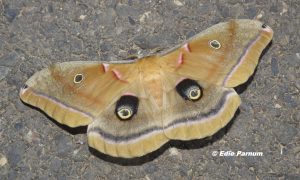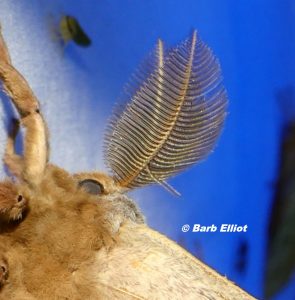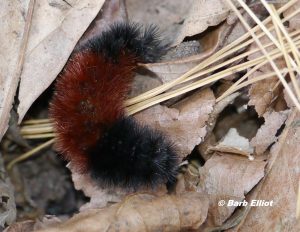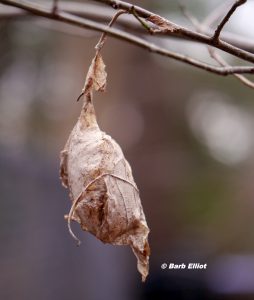By Edie Parnum
Moths are underappreciated. Most people think they’re dull and uninteresting. They ignore those nameless little moths that fly up while walking through the grass. Those moth pests in the kitchen cupboards are considered just that—pests. True, most of us

Hummingbird Clearwing (Hemaris thysbe)- a day-flying moth. © Barb Elliot Click to enlarge.
can be captivated by a large, daytime moth like a Hummingbird Clearwing Moth sipping nectar from flowers. However, because moths are usually nighttime creatures, most folks have little appreciation of their variety, esthetic appeal, and role in the web of life. As for myself, I confess to moth love.
Moth Night is now an annual event in my backyard. A few weeks ago, I invited nature-loving family members and friends for nighttime “mothing”. A few hours before sunset, I prepared for the occasion. Since a great many nocturnal moths are attracted to light, I hung two white cotton sheets and positioned lights in front of them. One light is a grow light and the other is a black light. Both of these attract moths because they project a wider range of UV light than standard incandescent or florescent light bulbs. Some moths do not come to lights. Instead, I lured them to a fermented concoction (see recipe below) I painted on tree trunks.
Once it was quite dark, we ventured out into the darkness. Using our flashlights or headlamps, we observed the moths attracted to the lighted sheets and tree trunks. By shining our lights back and forth in the garden, we found more moths hidden in the vegetation, especially on flowers. Sometimes their eyes reflected back to us. Big and small, ornate and plain, colorful and monochromatic—they were there.
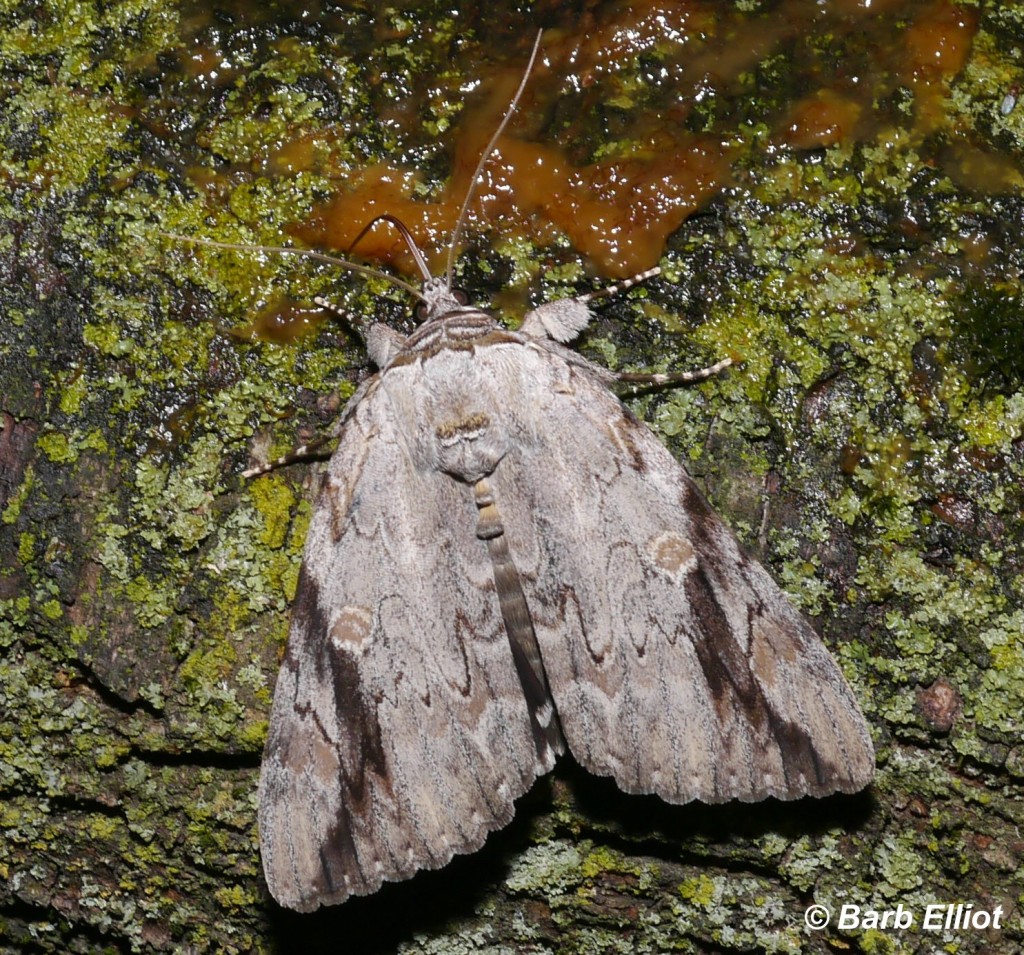
Sad Underwing. A 2″-long moth. © Barb Elliot. Click to enlarge.
We often heard someone say, “Look at this one!” That’s what my friend Mike said when he found the Sad Underwing (Catocala maestosa). We were happy to see this intricately patterned two-inch species. I presume it’s called “sad” because the underwing

The Sweetheart – a 2″ long moth. © Barb Elliot. Click to enlarge.
(hindwing) is plain. Another time Barb, my friend and colleague, discovered The Sweetheart (Catocala amatrix), an Underwing that charmed us with its rosy-pink hindwing pattern. The uncommon Hop’s Anglewing (Nyphonix segregata) was a good find that night.
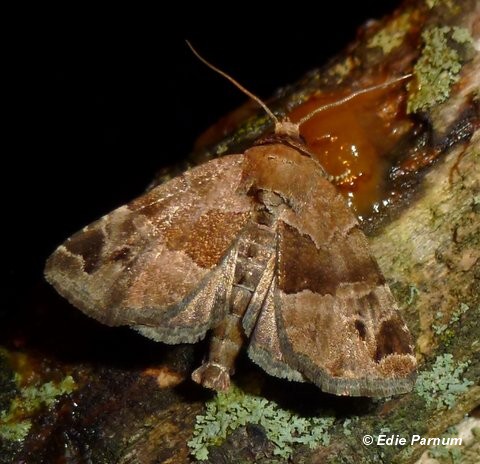
Hops Angleshade. © Edie Parnum. Click to enlarge.
We “moth-ers” exclaim “ooh” and “ah” frequently because moths are varied and beautiful creatures. They display a variety of colors including pink, purple, orange, green, and yellow. Some shimmer in the light or have iridescent spots. Those that are orange and black are toxic or pretending to be. True, many of them are just shades of tan and grey, but often the patterns are well-defined and elaborate. Others are camouflaged to look like dead leaves or bird droppings.
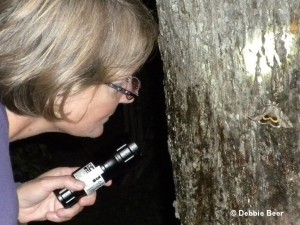
- Becky, a moth-er, looking at a Yellow-Banded Underwing (Catacola cerogama). @ Debbie Beer. Click to enlarge.
The shapes can be interesting, too. We see wings that are deeply scalloped, creased, or curled. The Plume Moths with their skinny wings look like miniature airplanes. Moth antennae sometimes resemble feathers. Bizarre hairy tufts can show up almost anywhere on their bodies: the legs, thorax, or abdomen.
By looking for the eye-shine of other creatures, we discovered bees, caterpillars, praying mantises, spiders, and cicadas. My nine-year-old grandson found and identified a Leopard Slug (a creature from the netherworld?) eating the bait on a tree trunk. We listened for night sounds, too, and heard the whinny of a screech owl and squeaks of flying squirrels.
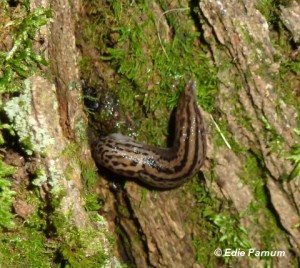
Leopard Slug. © Edie Parnum. Click to enlarge.
Many of us took photos and then later admired the details on our computer screens. That’s when I try my hand at moth ID. It’s difficult. After all, 11, 000 species of moths in North America have been identified. Moths outnumber butterfly species 11 to one.
After I’ve identified a moth, I note its host plants. These are the plants where the moth lived its earlier stages as an egg and caterpillar and where the female adult moth will lay eggs for the next generation. Many of these host plants grow on my property (see below). Although I live in a congested suburban area, my ¾-acre property has a good variety of the native perennials, grasses, and woody plants that moths use. And, I don’t use pesticides. It is moth-friendly habitat.
Why should we care about moths? Moths are important links in the web of life. The adult moths are good pollinators and are food for birds and bats. Birds, especially nestling birds, also feed on moths in their egg, larvae, or caterpillar stages. Small mammals, reptiles, and other insect predators consume moths in their various stages as well. In fact, insects power our ecosystem and are the most important animals of all.
Moths have lured me into the nighttime natural world of my backyard. Now I feel more intimately connected to the lives of moths and other creatures that contribute to my property’s biodiversity. I won’t wait until next year to hold another Moth Night. I’ve caught the moth bug.

Harris’s Three-Spot (Harrisimimna trisignata). © Edie Parnum. Click to enlarge.
——- For additional photographs of moths, see Moth Photo Gallery below —–
Edie’s Bait Recipe
- One or two overripe bananas, mashed
- Dollop of molasses
- Small scoop of brown sugar
- Glug or two of beer (stale is ok)
- No need to be precise. Mix together and adjust proportions to create a pancake batter consistency.
- Leave it for a day or two in a warm place. I like to take it outside for a few hours to let bees and flies add their contributions.
- With a paint brush, smear this concoction at eye level on tree trunks about an hour or two before sunset.
Resources
- Peterson Field Guide to Moths of Northeastern North America by David Beadle and Seabrooke Leckie, Houghton Mifflin Harcourt, 2012
- BugGuide. www.bugguide.net Images of moths and other insects Can submit ID request
- Butterflies and Moths of North America. www.butterfliesandmoths.org Images of butterflies and moths. Can submit ID request
- Moths of Eastern United States. http://www.facebook.com/groups/MothsoftheeasternUS Facebook group for members to post images and discuss sightings
Significant Native Plants to Host Moth Caterpillars
| Basswood |
Maples |
| Beech |
Oaks |
| Birches |
Pines |
| Blueberries |
Walnut |
| Elm |
Wild Cherry |
| Grasses |
Willows |
| Hickories |
Viburnums |
Moth Photo Gallery
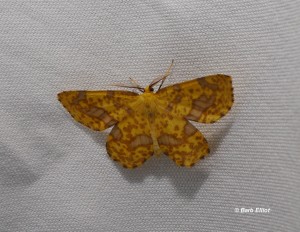
False Crocus Geometer (Xanthotype urticarial). © Barb Elliot. Click to enlarge.

- Lunate Zale (Zale lunata). – wingspan 2 1/4″. © Barb Elliot. Click to enlarge.

- Large Lace Borer (Scapula limoundata). © Barb Elliot. Click to enlarge.

Ailanthus Webworm Moth (Atteva aurea). © Barb Elliot. Click to enlarge.
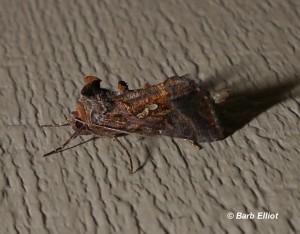
Common Looper (Autographa precationis). © Barb Elliot. Click to enlarge.

Raspberry Pyrausta (Pyrausta signatalis). © Barb Elliot. Click to enlarge.
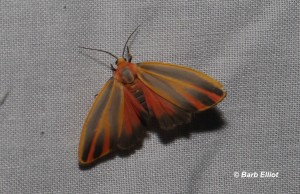
Painted Lichen Moth (Hypoprepia fucosa). © Barb Elliot. Click to enlarge.

